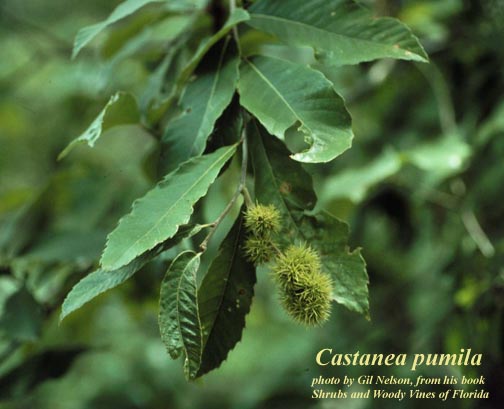Difference between revisions of "Castanea pumila"
(→Conservation and Management) |
(→Distribution) |
||
| Line 28: | Line 28: | ||
==Distribution== | ==Distribution== | ||
| − | ''C. pumila'' can be found along the southeastern coast of the United States, from Texas to Massachusetts. <ref name= "USDA Plant Database"/> | + | ''C. pumila'' can be found along the southeastern coast of the United States, from Texas to Massachusetts.<ref name= "USDA Plant Database"/> However, it is rare in its natural range.<ref name= "Wennerberg"> Wennerberg, S. (2006). Plant Guide: Chinkapin ''Castanea pumila''. N.R.C.S. United States Department of Agriculture. Baton Rouge, LA.</ref> |
==Ecology== | ==Ecology== | ||
Revision as of 11:37, 2 April 2019
Common name: Chinquapin [1], Common Chinquapin [2]
| Castanea pumila | |
|---|---|

| |
| Photo by the Atlas of Florida Plants Database | |
| Scientific classification | |
| Kingdom: | Plantae |
| Division: | Magnoliophyta - Flowering plants |
| Class: | Magnoliopsida - Dicots |
| Order: | Fagales |
| Family: | Fagaceae |
| Genus: | Castanea |
| Species: | C. pumila |
| Binomial name | |
| Castanea pumila (L) Mill. | |

| |
| Natural range of Castanea pumila from USDA NRCS Plants Database. | |
Contents
Taxonomic Notes
Synonyms: Castanea pumila (Linnaeus) P. Miller var. pumila, Castanea pumila (Linnaeus) P. Miller var. ashei Sudworth; Castanea alnifolia Nuttall var. alnifolia; Castanea alnifolia Nuttall var. floridana Sargent; Castanea ashei (Sudworth) Sudworth; Castanea floridana (Sargent) W.W. Ashe; Castanea alnifolia Nuttall
Varieties: none
Description
C. pumila is a perennial shrub/tree of the Fagaceae family native to North America.[1] Tree is single or multi-trunked with horizontal lower branches, which are ascending in the upper crown. Leaves toothed, glossy, and dark green that turn a yellow or purple tinge in the fall. Flowers unisexual and monoecious, a pale yellow spike that is long and pencil-like, and fruit is a nut that is enclosed in a bur-like prickly husk.[3]
Distribution
C. pumila can be found along the southeastern coast of the United States, from Texas to Massachusetts.[1] However, it is rare in its natural range.[4]
Ecology
Habitat
C. pumila is found in xeric forests and woodlands. [2] It is also found along sand ridges. [5] Additionally, C. pumila is found in deciduous woods, old field areas, and sandy soil areas. [6]
Phenology
C. pumila has been observed to flower between March and June. [7]
Seed bank and germination
For propagation purposes, seeds must be sown in the fall or stratified for germination with the husks removed. For best results, the seeds should be stratified between 30 and 60 days at 41 degrees.[3]
Fire ecology
C. pumila is found mostly in fire-maintained habitats. [2] It is not fire resistant, but has a high fire tolerance. [1]
Use by animals
C. pumila is highly palatable to browsing animals and is edible by humans, but is not very palatable to grazing animals.[1] The nuts were a favorite of Native Americans. It is also a larval host for the Orange-tipped oakworm moth (Anisota senatoria).[3]
Diseases and parasites
C. pumila is relatively resistant to chestnut blight. [2]
Conservation and Management
It is listed as threatened by the Kentucky State Nature Preserves Commission, and listed as endangered by the New Jersey Department of Environmental Protection and Energy.[1]
Cultivation and restoration
Photo Gallery
References and notes
- ↑ 1.0 1.1 1.2 1.3 1.4 1.5 USDA Plant Database https://plants.usda.gov/core/profile?symbol=CAPU9
- ↑ 2.0 2.1 2.2 2.3 Weakley, A. S. (2015). Flora of the Southern and Mid-Atlantic States. Chapel Hill, NC, University of North Carolina Herbarium.
- ↑ 3.0 3.1 3.2 [[1]] Lady Bird Johnson Wildflower Center. Accessed: April 2, 2019
- ↑ Wennerberg, S. (2006). Plant Guide: Chinkapin Castanea pumila. N.R.C.S. United States Department of Agriculture. Baton Rouge, LA.
- ↑ Johnson, A. S. and J. L. Landers (1978). "Fruit production in slash pine plantations in Georgia." The Journal of Wildlife Management 42(3): 606-613.
- ↑ URL: http://herbarium.bio.fsu.edu. Last accessed: June 2018. Collectors: Loran C. Anderson, Robert K. Godfrey, Wayne R. Faircloth, A. F. Clewell, C. Jackson, H. Kurz, W. D. Reese, Wilson Baker, R. Kral, Robert W Simons, Richard S. Mitchell, Erdman West, Angus Gholson, George P. Johnson, Lucy B. Abbe, Ernst C. Abbe, Robert F. Martin, R. F. Thorne, R. A. Davidson, D.B. Ward, R.B. Smith, John K. Small, Ed Keppner, Lisa Keppner, Rodie White, R. Komarek, Andre F. Clewell, D. Demaree, Kathleen Craddock Burks, Travis MacClendon. States and counties: Leon County Florida, Calhoun County Florida, Santa Rosa County Florida, Wakulla County Florida, Suwannee County Florida, Hamilton County Florida, Walton County Florida, Okaloosa County Florida, Columbia County Florida, Jackson County Florida, Alachua County Florida, Duval County Florida, Escambia County Florida, Madison County Florida, Gilchrist County Florida, Bay County Florida, Liberty County Florida, Washington County Florida, Gadsden County Florida, Grady County Georgia, Thomas County Georgia, Decatur County Georgia, Carroll County Arkansas, Franklin County Florida, Autauga County Alabama.
- ↑ Nelson, G. PanFlora: Plant data for the eastern United States with emphasis on the Southeastern Coastal Plains, Florida, and the Florida Panhandle. www.gilnelson.com/PanFlora/ Accessed: 18 MAY 2018